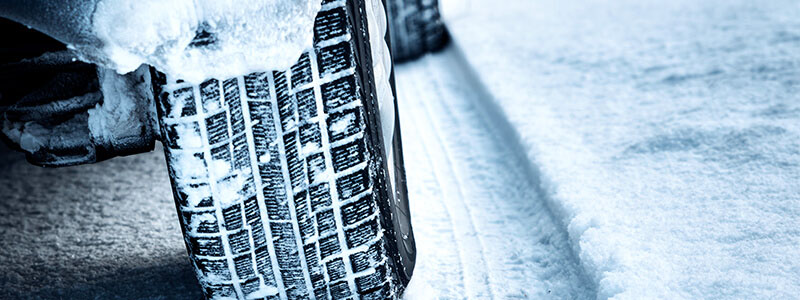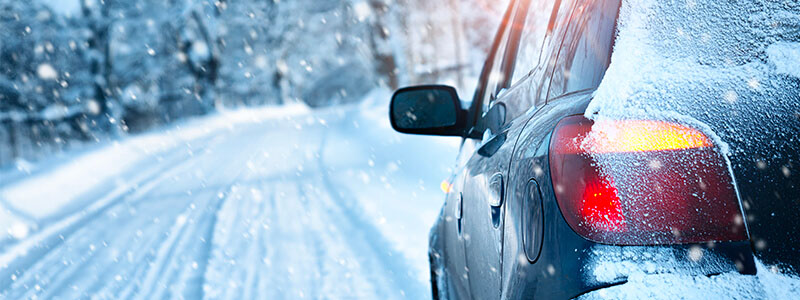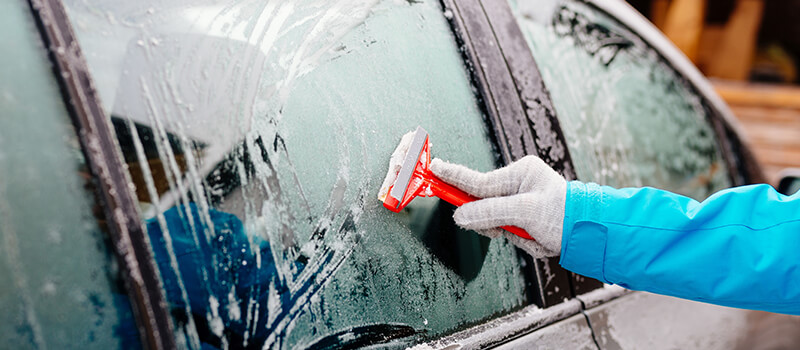Although it’s rare you’ll experience heavy snow in the UK, it’s vital to ensure you are fully prepared for these types of conditions. Driving in the ice and snow can be tricky, and the likelihood of accidents is greatly increased. Many drivers ask themselves “Should I drive in the snow? The greatest piece of advice we have on this is if you don’t feel confident driving in the ice and snow, then don’t.

How do I drive in the ice and snow?
Sometimes, it is necessary to drive in treacherous cold weather. To ensure that you stay safe whilst on your journey, we have compiled some of our top tips for driving in the snow.
- Plan ahead
- What gear to drive in the snow?
- Clear all ice and snow before setting off
- How to defrost your car
- Important don’ts for de-icing your car
- Brake slowly and smoothly
- Bring sunglasses and supplies
- Use dipped headlights
- Leave extra space
- Steer smoothly
- Hidden road markings
- Snow and ice on your driving test
- Instructor advice on driving in the snow and ice
What is the best vehicle to drive in the snow?
We at driveJohnson’s are often asked, “What is the best vehicle to drive in the snow?” With the road conditions difficult, we want to know our car won’t let us down when the going literally gets tough outside. If you are looking to buy a car with this in mind, or have a couple of cars at home to choose from, there are a few general rules that apply.
Are rear-wheel drive cars good in the snow?
Rear-wheel drive cars perform the worst in snow as they have their driving wheels at the back. Due to these pushing the car forward rather than pulling, when a rear-wheel car accelerates in the snow and ice, its tail end is more likely to slide. If you are driving a rear-wheel drive car and this happens, you must quickly countersteer to avoid spinning.
Are front-wheel drive cars good in the snow?
Yes they are. You will find that, as most of the weight of front-wheel drive cars sits over the tyres they drive with (i.e. their front wheels) they gain more traction with them. They are also less likely to go into a spin as the front wheels pull the car rather than push it, maintaining their course even without good traction.
What about all-wheel or 4-wheel drive cars?
These are the best for driving in the snow and ice. With all of their wheels providing traction, they find it easier to grip the ice and snow than rear-wheel drive cars. They can also accelerate faster than front-wheel drive cars can. In slippery conditions, all-wheel cars will automatically direct power to the wheels that are gaining traction, meaning that if you are on a patch of ice, you are less likely to slide. 4-wheel cars send power to their tyres equally so do not operate in the same way; however, as all four wheels are still being sent power, they are still likely to gain more traction than rear-wheel or front-wheel cars on ice.
Automatic vs manual on snow
Both automatic and manual cars can handle well in the snow. With a manual, you have more control over how much torque you apply as you pick the gears. With an automatic, the car itself automatically applies the gears which means it can apply too much torque on the ice. This can be particularly noticeable when you are trying to pull away in the snow (see What gear to drive in the snow?). However, some automatic cars have a special mode for winter conditions that compensates for this.
Are winter tyres worth it?
Winter tyres are specialist tyres designed to improve how your car handles and grips in cold conditions. They work best at temperatures colder than minus 7 degrees Celsius and are, on average, slightly more expensive than the equivalent summer tyre. They will have to be fitted and will need to be stored somewhere when they are not being used. However, they do provide a noticeable reduction in stopping distances compared to summer tyres. In most parts of the UK, it isn’t often that the temperature will be low enough to see the true benefit of winter tyres, but if you do live somewhere colder and more remote, such as the Scottish Highlands, then it may be worth considering the investment.
Plan ahead
Before setting off, spend some time looking through the latest news to make yourself aware of any road closures in areas with heavy snow. You can then plan your route to avoid any potentially difficult areas.
Whilst driving, stay listening to the traffic updates or keep your satnav on, just in case. Roads can quickly become impassable in heavy snow so it can pay to stay up to date with what is happening on your route.
Driving in snow and, particularly ice, makes it increasingly harder for your tyres to grip onto the road surface. It is always important to check tyre pressure, but even more important when planning to drive in icy conditions. Tyres need to be inflated to their full capacity with a tread depth of 3mm. It is also handy to keep a spare tyre in the boot of your vehicle in case of emergencies. Having a spare tyre means that if you break down, you will not have to wait around for hours in the cold for assistance.
What gear to drive in the snow?
Snow and/or ice on the ground are the only exceptions to the rule that you must pull off in first gear. Initially moving off from stationary in second gear, whilst slowly releasing the clutch, will reduce the risk of wheel spin. If your wheels spin when setting off, don’t overrev the engine. Your tyres have less grip when spinning and your wheels can dig in deeper, making it harder to move.
Drive in as high a gear as possible to help prevent your wheels from spinning. When slowing down, change to a lower gear earlier than normal so that the engine can hold the car back as well as the brakes. This is especially effective on hills.
Clear all ice and snow before setting off
To keep yourself safe, as well as those around you, you must clear all ice and snow from your car BEFORE you set off on your journey. If you don’t, it can come away from your car whilst you are driving (especially at high speeds) and can cause damage and hazards to other vehicles, as well as potentially causing accidents.
Removing all ice and snow from your car includes:
- Your windscreen. Research has shown that the majority of motorists have admitted to “portholing”, where they don’t properly clear the ice or snow from their windows and instead choose to leave a small “porthole” to see through. This is illegal, and you can be charged a penalty fine if caught doing this.
- The top of your car. If you do not remove all snow from the top of your car, it is likely to fall onto your windscreen whilst driving, creating blind spots.
- Demisting the inside of your car windows to ensure you can see out of them properly. With the car parked, you can turn on the fans inside the car, dialling them up to maximum, to speed along this process.
- Rear windows and side windows. These are essential to seeing any hazards around the car, so they must not be overlooked or neglected.
- Mirrors. Though easy to forget, try to remember to clear any snow or ice from your side mirrors.
How to defrost your car
To remove any snow and ice, start your engine and use the heater settings to clear the windscreen as much as possible. Once the heat starts to clear parts of the windscreen and windows, then use de-icer and an ice scraper on the remainder of the ice. When using a scraper, it is best to perform broad strokes across the entirety of the window or screen.
The above process will take some time, so ensure you factor this extra effort into your schedule before you make plans to set off. When you need to travel during the colder months, check the weather the night before; if you know it’s going to be sub-zero temperatures, you can then factor extra de-icing time into your overall journey.
Other tips we would recommend are:
- Park your car under a covered area. This will mean you have less snow to remove and perhaps less ice (depending on the car’s location) on the coldest mornings.
- De-icing sprays work, but if the car is left unattended for just a few minutes with no heat inside the car, then it may ice over again. Spray the car, then sit inside with the heat turned up to get the best result.
- Watch out that when you blast hot air into your car, it doesn’t make your windows foggy. If it does, then make sure the aircon is on as well.
Important don’ts for de-icing your car
- Don’t use something other than an ice scraper to de-ice your car. In a survey of 2000 people, one in 20 people (5%) said that they had unfortunately scratched their windscreen using something other than an ice scraper, such as a kitchen utensil, to de-ice it. Only a specialised windscreen scraper should be used to clear ice.
- Don’t use boiling water to melt the ice from your windscreen. Of the 22% of people surveyed who said they’ve used boiling water, around one in six (16%) said that the windscreen cracked.
- Don’t take shortcuts! 28 of the survey’s respondents admitted to taking a rather extreme approach and using a flame-thrower (either a professional one or a lighter and aerosol can) or a blow torch to de-ice their car. This is highly dangerous, and the consequences – a damaged car or a damaged you (!) – are not worth it.
Driving without proper visibility puts others at risk as well as yourself. Our driving instructor in London, Domenico Cifaldi, regularly sees drivers in their cars who haven’t properly cleaned their windscreens. He said, “It is incredibly dangerous, especially with London’s hustle and bustle. When it comes to driving, you always need to ensure you are safe, and when you are in a busy area where people can appear from any direction. You must have full visibility.”
Brake slowly and smoothly
Braking too quickly on ice will cause your wheels to lock – this is the biggest cause of skidding. Keep braking slow and smooth, especially when turning corners. Don’t worry about holding other drivers up; remember everyone is in the same boat. If your car doesn’t have anti-lock brakes, release and reapply your brakes if you start to skid.
Bring sunglasses and supplies
There should already be a spare pair of sunglasses in your car for driving in the sun, but these will also be handy for when there is snow on the ground. Sun will reflect against the white snow causing a huge glare, so keep visibility at a high by wearing sunglasses.
Take a few supplies with you, just in case. We would recommend packing a blanket, a bottle of water and a snack. Should the worst happen and you get stuck, have an accident or breakdown, you will then have some food and water with you whilst you wait for help, plus a blanket to keep you warm.
Ensure that you keep your mobile phone with you, in case you need assistance. It is also good practice to let someone know where you are heading and those at your destination know when to expect you to arrive; they can raise the alarm if you are very late.
Always bring a coat with you if you are driving in cold weather. If the car heater turns off for any reason, you will still be warm. Otherwise, you could get into trouble very quickly in the freezing conditions.
Use dipped headlights
If snow is falling heavily, even if it is during the day, switch on your dipped headlights. This will ensure that you can be seen and, even if your car gets covered in snow, other drivers will still be aware of you.
Leave extra space
Make sure to leave more space than you normally would between you and the car in front. They may get into trouble and slip backward or skid. By increasing the gap between you and them, you’ll be far enough away should they experience any problems. You can read more about the emergency stop and stopping distances here.
Steer smoothly
Don’t change directions suddenly or steer too quickly as this will increase your chances of skidding and losing control of your vehicle. When turning from a major onto a minor road, be prepared for the smaller road to be icy, as these are rarely treated by gritters and can be extremely slippy.
Hidden road markings
Be aware that road markings and signs may well be hidden underneath snow, so you’ll need to pay close attention in order to spot them and adjust your driving accordingly.

Snow and ice on your driving lessons and test
When the first flurries of snow start to fall, many of our learner drivers start wondering, “Do driving lessons get cancelled in the snow?” The answer is yes, but only if your driving instructor considers it unsafe to go ahead. Your instructor will ensure that any lesson takes place under safe conditions so, depending on the road conditions and your experience, they may alter their plans for that lesson and ensure that you stick to gritted main roads. If the road conditions are too hazardous, they will be in touch with you to rearrange the lesson for another time.
If snow has settled, or the ground is icy on the day of your driving test, call your test centre a couple of hours before your test. You can find the necessary contact details on your test booking confirmation. If your test is first thing in the morning, call as soon as possible. If it is in the afternoon, wait it out until an hour or so before your test is due to start. Weather changes quickly so try to call as close to the time as you can.
Your examiner will check a handful of routes and see whether any routes are fully safe and if all surfaces are clear. A test route involving mainly gritted main roads may still go ahead. If a test route consists of a lot of country roads or residential areas, your test is unlikely to go ahead.
If your driving test gets canceled due to adverse weather conditions, the DVSA will rearrange the test for you. They will aim to book you in for the closest available test possible. You should hear back from them within 3-7 days with full details.
Instructor advice on driving in the snow and ice
We spoke to Alec Crump who is a driving instructor in Luton (an area known for being heavily built up with housing estates and new grid systems) about teaching in Luton in winter conditions.
“Over the past 10 years of teaching pupils in Luton, I’ve had to constantly alter the way I teach to suit the new changes in the town. Of course, if the weather has reached a dangerous stage, lessons won’t go ahead, but I find that I’m quite lucky with roads being cleared from ice because of all of the traffic coming to and from the airport. I always try to encourage my pupils to face their fears and brave driving in harder conditions. The more practice they can get with me in the car for support, the more confident they’ll become when they’re faced with driving alone!”
Stay safe
When the weather is freezing and the roads treacherous, we would always recommend avoiding driving. However, when this is not possible and you still have to drive, keep yourself safe by planning ahead. As you can see above, there are many ways you can improve your driving experience and ensure that you get from A to B without any problems. Otherwise, stay inside and snuggle up in the warm indoors instead.







